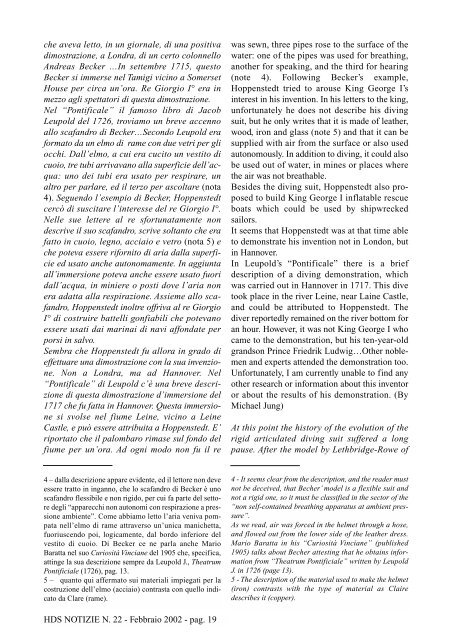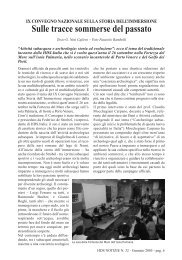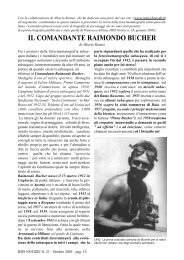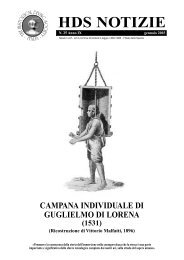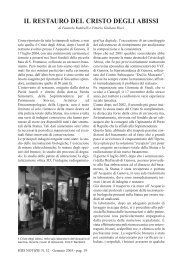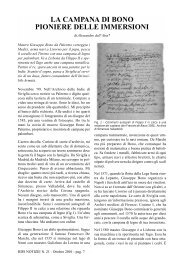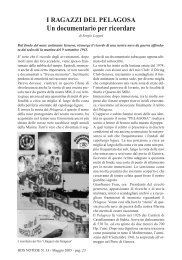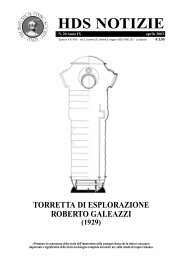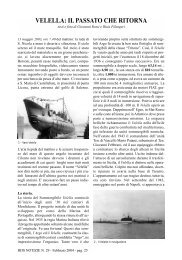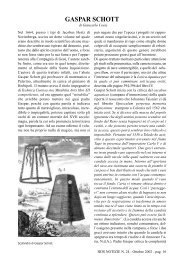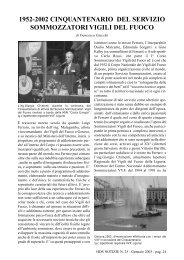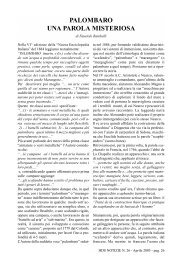hds internet - The Historical Diving Society Italia
hds internet - The Historical Diving Society Italia
hds internet - The Historical Diving Society Italia
Create successful ePaper yourself
Turn your PDF publications into a flip-book with our unique Google optimized e-Paper software.
che aveva letto, in un giornale, di una positiva<br />
dimostrazione, a Londra, di un certo colonnello<br />
Andreas Becker …In settembre 1715, questo<br />
Becker si immerse nel Tamigi vicino a Somerset<br />
House per circa un’ora. Re Giorgio I° era in<br />
mezzo agli spettatori di questa dimostrazione.<br />
Nel “Pontificale” il famoso libro di Jacob<br />
Leupold del 1726, troviamo un breve accenno<br />
allo scafandro di Becker…Secondo Leupold era<br />
formato da un elmo di rame con due vetri per gli<br />
occhi. Dall’elmo, a cui era cucito un vestito di<br />
cuoio, tre tubi arrivavano alla superficie dell’acqua:<br />
uno dei tubi era usato per respirare, un<br />
altro per parlare, ed il terzo per ascoltare (nota<br />
4). Seguendo l’esempio di Becker, Hoppenstedt<br />
cercò di suscitare l’interesse del re Giorgio I°.<br />
Nelle sue lettere al re sfortunatamente non<br />
descrive il suo scafandro, scrive soltanto che era<br />
fatto in cuoio, legno, acciaio e vetro (nota 5) e<br />
che poteva essere rifornito di aria dalla superficie<br />
ed usato anche autonomamente. In aggiunta<br />
all’immersione poteva anche essere usato fuori<br />
dall’acqua, in miniere o posti dove l’aria non<br />
era adatta alla respirazione. Assieme allo scafandro,<br />
Hoppenstedt inoltre offriva al re Giorgio<br />
I° di costruire battelli gonfiabili che potevano<br />
essere usati dai marinai di navi affondate per<br />
porsi in salvo.<br />
Sembra che Hoppenstedt fu allora in grado di<br />
effettuare una dimostrazione con la sua invenzione.<br />
Non a Londra, ma ad Hannover. Nel<br />
“Pontificale” di Leupold c’è una breve descrizione<br />
di questa dimostrazione d’immersione del<br />
1717 che fu fatta in Hannover. Questa immersione<br />
si svolse nel fiume Leine, vicino a Leine<br />
Castle, e può essere attribuita a Hoppenstedt. E’<br />
riportato che il palombaro rimase sul fondo del<br />
fiume per un’ora. Ad ogni modo non fu il re<br />
was sewn, three pipes rose to the surface of the<br />
water: one of the pipes was used for breathing,<br />
another for speaking, and the third for hearing<br />
(note 4). Following Becker’s example,<br />
Hoppenstedt tried to arouse King George I’s<br />
interest in his invention. In his letters to the king,<br />
unfortunately he does not describe his diving<br />
suit, but he only writes that it is made of leather,<br />
wood, iron and glass (note 5) and that it can be<br />
supplied with air from the surface or also used<br />
autonomously. In addition to diving, it could also<br />
be used out of water, in mines or places where<br />
the air was not breathable.<br />
Besides the diving suit, Hoppenstedt also proposed<br />
to build King George I inflatable rescue<br />
boats which could be used by shipwrecked<br />
sailors.<br />
It seems that Hoppenstedt was at that time able<br />
to demonstrate his invention not in London, but<br />
in Hannover.<br />
In Leupold’s “Pontificale” there is a brief<br />
description of a diving demonstration, which<br />
was carried out in Hannover in 1717. This dive<br />
took place in the river Leine, near Laine Castle,<br />
and could be attributed to Hoppenstedt. <strong>The</strong><br />
diver reportedly remained on the river bottom for<br />
an hour. However, it was not King George I who<br />
came to the demonstration, but his ten-year-old<br />
grandson Prince Friedrik Ludwig…Other noblemen<br />
and experts attended the demonstration too.<br />
Unfortunately, I am currently unable to find any<br />
other research or information about this inventor<br />
or about the results of his demonstration. (By<br />
Michael Jung)<br />
At this point the history of the evolution of the<br />
rigid articulated diving suit suffered a long<br />
pause. After the model by Lethbridge-Rowe of<br />
4 – dalla descrizione appare evidente, ed il lettore non deve<br />
essere tratto in inganno, che lo scafandro di Becker è uno<br />
scafandro flessibile e non rigido, per cui fa parte del settore<br />
degli “apparecchi non autonomi con respirazione a pressione<br />
ambiente”. Come abbiamo letto l’aria veniva pompata<br />
nell’elmo di rame attraverso un’unica manichetta,<br />
fuoriuscendo poi, logicamente, dal bordo inferiore del<br />
vestito di cuoio. Di Becker ce ne parla anche Mario<br />
Baratta nel suo Curiosità Vinciane del 1905 che, specifica,<br />
attinge la sua descrizione sempre da Leupold J., <strong>The</strong>atrum<br />
Pontificiale (1726), pag. 13.<br />
5 – quanto qui affermato sui materiali impiegati per la<br />
costruzione dell’elmo (acciaio) contrasta con quello indicato<br />
da Clare (rame).<br />
4 - It seems clear from the description, and the reader must<br />
not be deceived, that Becher’ model is a flexible suit and<br />
not a rigid one, so it must be classified in the sector of the<br />
“non self-contained breathing apparatus at ambient pressure”.<br />
As we read, air was forced in the helmet through a hose,<br />
and flowed out from the lower side of the leather dress.<br />
Mario Baratta in his “Curiosità Vinciane” (published<br />
1905) talks about Becher attesting that he obtains information<br />
from “<strong>The</strong>atrum Pontificiale” written by Leupold<br />
J. in 1726 (page 13).<br />
5 - <strong>The</strong> description of the material used to make the helmet<br />
(iron) contrasts with the type of material as Claire<br />
describes it (copper).<br />
HDS NOTIZIE N. 22 - Febbraio 2002 - pag. 19


